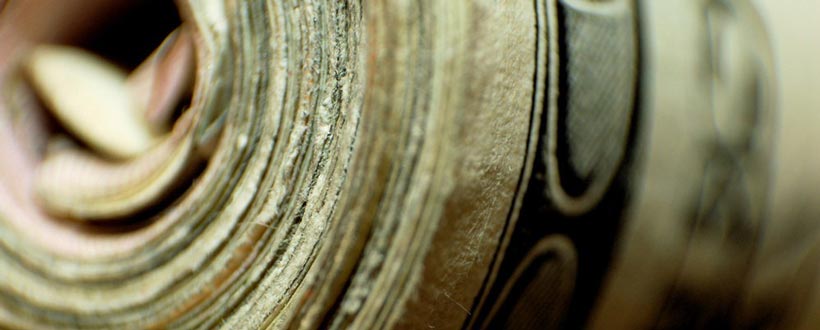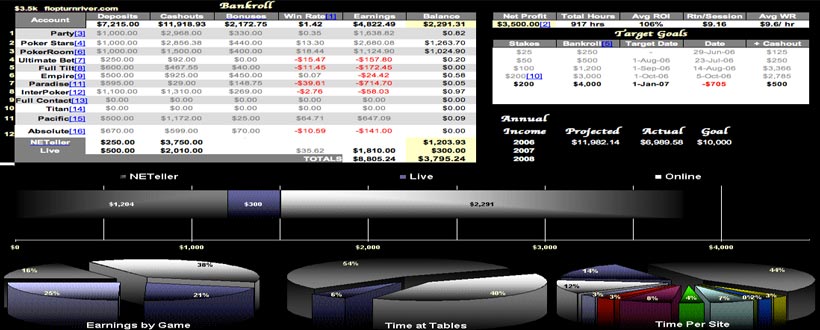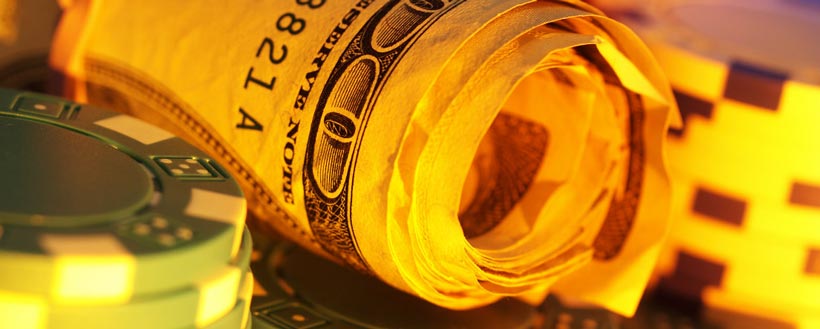Learn how to do proper shot taking at higher stakes and use your bankroll most effectively. Understanding bankroll management is key for any player.

A huge factor in being able to successfully move up the limits is understanding the correct approach to bankroll-management and shot-taking. If our BRM is wired too tight it can take years to make any significant progress, while if our BRM is overly
loose we greatly increase our risk of ruin.
Understanding when and how to take a shot is also crucial. If we shoot the next limit with too many buyins, shoot the next limit in the wrong way, or
have a bad mental state when we take the shot,
we are setting ourselves up for failure.
Let’s consider a few of the basic principles we need in order to make a success of moving up the limits.
Basic BRM
 Let’s start with the absolute basics. This should not come as a surprise to us in any way. If we don’t already have our precise bankroll management strategy mapped out neatly in a text document, then we should do this immediately. Otherwise it’s essentially like trying to run a business on a day to day basis without seeing the overall picture.
Let’s start with the absolute basics. This should not come as a surprise to us in any way. If we don’t already have our precise bankroll management strategy mapped out neatly in a text document, then we should do this immediately. Otherwise it’s essentially like trying to run a business on a day to day basis without seeing the overall picture.
This doesn’t need to be a complicated document, it simply needs the following.
- How many $ do I need in my roll before I shoot the next limit?
- How many buyin shot will I take before moving back down?
- When will I move to the limit after?
- At what stage will I move back down a further limit if my shot fails and I swing down?
So for example, we are a 10nl player, our notepad document is going to look something like this…
- Shoot 25nl at $875
- Take a 5 buyin shot (if it fails rebuild at 10nl)
- If bankroll drops to $225, rebuild at 5nl
- Shoot 50nl at $2000
- Take a 5 buyin shot (if it fails rebuild at 25nl)
- If bankroll drops to $750, rebuild at 10nl
It’s amazing how many players don’t do the last step. It’s probably somewhat normal to just assume that if our shot fails that we will not
go on an extended downswing and have to move down an additional limit.
It’s still a possibility though and we need a contingency plan for this scenario. It’s usually at this stage that playerss have a tendency to self-destruct and
tilt off their remaining roll. They never had a concrete plan for a scenario they assumed would never happen and have a difficult time keeping their cool.
Approach to Shot Taking

Shot taking is not typically something we see players having deep strategic conversations about. The current advice is more along the lines of “It’s your roll, so shoot as many buyins as you feel comfortable with”.
Well, naturally this is true, but it’s not overly useful advice. There should be some strategic pointers we can use in order to
maximise our long-run EV. We already mentioned one of the pitfalls at the outset, which was following too stringent of a BRM plan.
1. Short shots are best
Let’s think about 2 different approaches to shot taking. From our sample bankroll management plan above we can see that upon arriving at $875 our plan is to take a 5 buyin shot at nl25. Our threshold for moving back down to 10nl is therefore $750. Let’s compare this with someone who has the same moving-down threshold but likes to take a 20buyin shot at the next limit.
- Player 1 – Moves up at $875, takes 5buyin shot.
- Player 2 – Moves up at $1250, takes 20 buyin shot.
 So why is player 2 taking a 20 buyin shot?
So why is player 2 taking a 20 buyin shot? Usually players rationalise as follows - “I really hate it when my shots fail, I’d much rather save up and have a really good shot at the limit so it’s less likely I’ll need to move down” Perhaps this rings a bell on an emotional level, but is it actually strategically sound?
Well imagine for a minute that we only drop 1 buyin on our 25nl shot before going on a huge upswing. It wouldn’t have actually made any difference to us whether we were taking a 5-buyin shot or a 20-buyin shot. The main difference is that
in order to take a 20-buyin shot we have to spend countless hours grinding at the lower limit, even though our roll is already in ok shape to take the shot.
Some might contest that the 20 buyin shot is still better because if we were to drop over 5 buyins on our shot we’d be forced to move down and grind the lower limit. But even if our shot fails twice and succeeds on our third attempt,
we will have still spent less time grinding the lower limit compared to the scenario where we shoot 20 buyins all at once. It should be somewhat obvious that strategically, the shorter shot is significantly better than the bigger shot.
2. Abandon the “Do or Die” approach

Players have a real tendency to screw themselves over before they have even begun. They have saved up a ridiculous amount of buyins for the shot and have thoughts of “This is it!”¸ “I’m either gonna make it big or go down in flames!”. If we ever think like this then there is a very reasonable chance the outcome will be going down in flames.
The approach to shot taking (while short and aggressive), should be a little bit more gradual than most players imagine. The first time we sit down at the next limit
we should think of it more as a scouting mission than an attempt to make real money. We should play tighter than usual and set our main goal as simply becoming established at the limit.
 We should show a tendency towards avoiding coin flip situations.
We should show a tendency towards avoiding coin flip situations. Remember that even if something is break-even or marginally profitable in terms of chip-EV,
does not mean that we have to take it. There is another factor at work here: given the choice we’d prefer not to move down limits since there is a time cost associated with this.
That time cost should be assigned a real value. It’s a little similar to considering an ICM model in a poker tournament. A decision may be clearly profitable in terms of chip-EV but not necessarily the correct decision in terms of $EV. Shot taking with a limited amount of shots should be viewed in a similar way; we don’t always want to purely look at chip-EV as cash game players are typically inclined to do. We won’t assign any formal maths to the situation, but just keep in mind there are other factors at work when shot-taking, not just the outright profitability of the decisions we make.
Some players will also
consider mixing tables in the early stages of shot taking. So rather than jumping immediately from 4 tables of fast 10nl poker to 4 tables of fast 25nl poker, we can consider playing 3 tables of 10nl and mixing a 25nl table. This can help us not to get stressed about moving up limits, and
our profits at 10nl will help us to offset any losses at 25nl until we become established at the limit.3. The next limit is not that much harder

It’s common for players to have a real mental hangup when thinking about their projected profits at the next limit. They will say stuff like → “Well, I’m making 5bb/100 at 5nl so I should probably expect to make less than 2.5bb/100 at 10nl”.
There seems to be an unwritten assumption that if we double the stakes we also double the skill level of our opponents. If each limit really was twice as hard, then we’d all be in big trouble.
The truth is that the skill gap between one limit and the next is not even close to as wide as the average player thinks. We can say this another way – micro-stakes games are lot harder than most people think, and small or mid-stakes games are a lot easier than most people think.
So if we have a winrate of 6bb/100 at 5nl, we probably also have a similar winrate at 10nl, perhaps slightly lower. If our winrate is significantly lower over a large sample, then this is
often a mindset problem. This is why sometimes we see guys who are beating 2nl at 10bb/100, and then losing at 5nl for -4bb/100, both over a reasonable sample.
There is absolutely no way that a 10bb/100 crusher at 2nl can be losing at 5nl unless he has some kind of serious mindset problem.

In other words if we have any kind of positive winrate at our current limit, and we have the roll to move up,
we should think about doing it immediately. Sometimes people make the mistake of “waiting until their winrate improves before moving up”. This is usually going to be a mistake for the following 2 reasons.
- It’s almost impossible to define accurately what our winrate is. By the time we have a large enough sample to accurately state our winrate, our winrate will probably have changed.
- Not all styles of poker will have a decreased winrate when moving up. Some may even increase in profitability.
It’s this second point which is often never considered and is somewhat fascinating. Some poker styles will actually work better at higher limits than lower limits because they naturally exploit the player pool better. We should also remember that the higher up in limits we go, the lower the associated rake cost of each hand we play.So even if our winrate is low, if we have the roll, we should frequently just take a shot and see what happens. This will be the highest EV strategy in the long run.
4. Fix Your Mindset

We mentioned earlier about the grinder who moves up one limit and experiences a huge and
dramatic drop in winrate. There are 2 main mindset issues players face, although there are certainly a
range of additional mindset issues that we will not cover.
- Scared Money – The new stakes feel so large and we are feeling nervous. This extra nervous energy has the ability to shut down our rational thought processes. It is impossible to simply shut out fear, but there are steps we can take to improve our mental state. Treating the first shot as simply a scouting mission and/or gradually introducing the higher limit tables, should help to keep our mental state much more manageable.
 Rapid Adjustments – So imagine we suddenly start getting 3-bet a lot at our current limit. Do we automatically assume that everyone has become more aggressive overnight? No, this would be illogical, we just assume that we are running into a patch of variance. But when players move up a limit and suddenly go through a patch where they face a ton of 3bets, what do they assume? Often they assume something along the lines of “ I guess everyone is a lot more aggressive at this limit, I should start playing back”. This is not a statement we can make until we have played at least 10k hands at the limit.
Rapid Adjustments – So imagine we suddenly start getting 3-bet a lot at our current limit. Do we automatically assume that everyone has become more aggressive overnight? No, this would be illogical, we just assume that we are running into a patch of variance. But when players move up a limit and suddenly go through a patch where they face a ton of 3bets, what do they assume? Often they assume something along the lines of “ I guess everyone is a lot more aggressive at this limit, I should start playing back”. This is not a statement we can make until we have played at least 10k hands at the limit.
Assuming that we know something about the limit after playing a mere few hundred hands can be very dangerous. Perhaps we start stacking off lighter and wonder why we run into AA every time. It’s because the new limit is not really that different at all, but we need to play a decent sample before we understand which adjustments to make. In most cases we should stick to our current game as we move up to the next limit – if we find ourselves making sudden huge adjustments to our strategy then this is one reason why it seems impossible for us to ever crack the next limit up.
Summary
Armed with the suggestions in this article
we should be able to take our shot-taking strategy to a higher level. One of the biggest losses in future potential which players suffer from, is
not taking shots aggressively enough. Naturally we do not want to advise playing outside of reasonable
bankroll management rules, this is very important. But the highest long-term EV strategy is always to
take shots as frequently and as aggressively as possible.Other Top Recommended Content
If you enjoyed reading this article, take a look at some of our other top recommended content by Adam Jones.
ArticlesCoaching Videos



 In other words if we have any kind of positive winrate at our current limit, and we have the roll to move up, we should think about doing it immediately. Sometimes people make the mistake of “waiting until their winrate improves before moving up”. This is usually going to be a mistake for the following 2 reasons.
In other words if we have any kind of positive winrate at our current limit, and we have the roll to move up, we should think about doing it immediately. Sometimes people make the mistake of “waiting until their winrate improves before moving up”. This is usually going to be a mistake for the following 2 reasons.
 Rapid Adjustments – So imagine we suddenly start getting 3-bet a lot at our current limit. Do we automatically assume that everyone has become more aggressive overnight? No, this would be illogical, we just assume that we are running into a patch of variance. But when players move up a limit and suddenly go through a patch where they face a ton of 3bets, what do they assume? Often they assume something along the lines of “ I guess everyone is a lot more aggressive at this limit, I should start playing back”. This is not a statement we can make until we have played at least 10k hands at the limit.
Rapid Adjustments – So imagine we suddenly start getting 3-bet a lot at our current limit. Do we automatically assume that everyone has become more aggressive overnight? No, this would be illogical, we just assume that we are running into a patch of variance. But when players move up a limit and suddenly go through a patch where they face a ton of 3bets, what do they assume? Often they assume something along the lines of “ I guess everyone is a lot more aggressive at this limit, I should start playing back”. This is not a statement we can make until we have played at least 10k hands at the limit.

